Comprehensive Report on Financial Resources Management and Planning
VerifiedAdded on 2020/07/22
|14
|4065
|230
Report
AI Summary
This report provides a detailed analysis of financial resource management, crucial for business success. It explores various sources of finance, including internal (equity) and external (loans), evaluating their implications and costs. The report emphasizes the importance of financial planning, identifying capital requirements, determining capital structure, and managing funds effectively. It also discusses the information needed for sound financial decision-making and the impact of finance on financial statements, using Vodafone Limited's budget as a case study. Furthermore, the report delves into calculating unit costs, making pricing decisions, and assessing project viability. It concludes with an examination of major financial statements and their interpretation using appropriate tools, providing a comprehensive overview of financial resource management strategies.
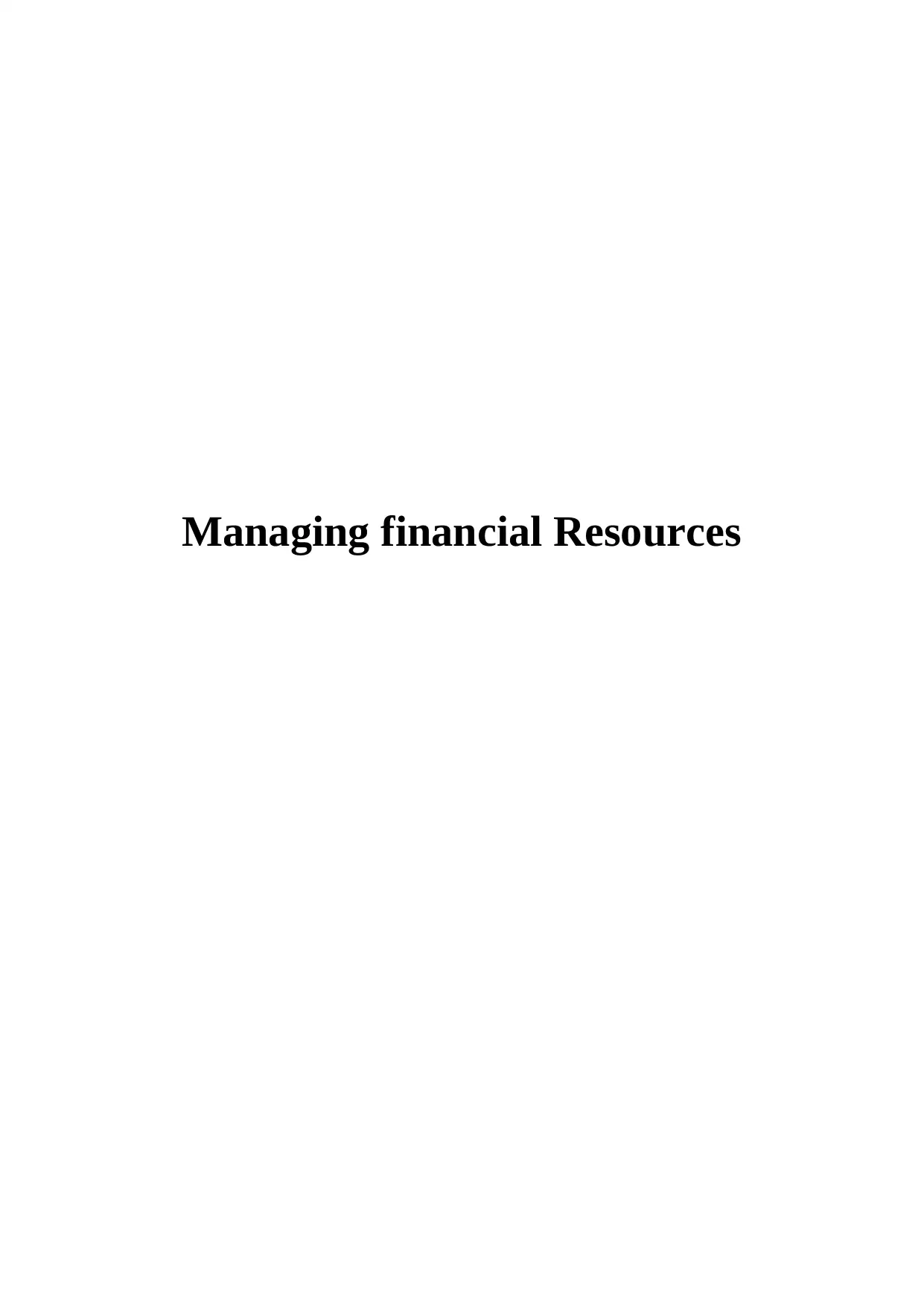
Managing financial Resources
Paraphrase This Document
Need a fresh take? Get an instant paraphrase of this document with our AI Paraphraser
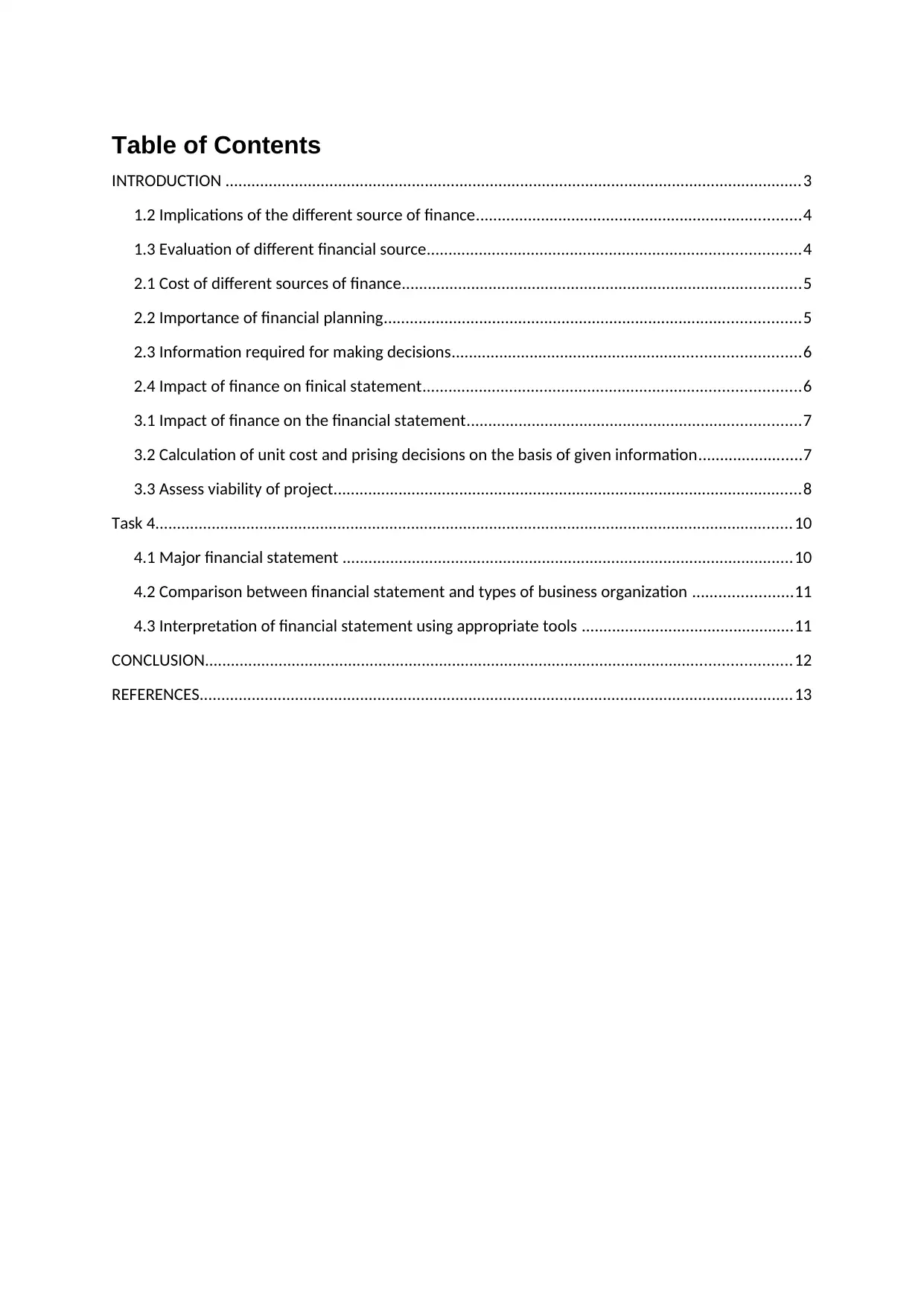
Table of Contents
INTRODUCTION .....................................................................................................................................3
1.2 Implications of the different source of finance...........................................................................4
1.3 Evaluation of different financial source......................................................................................4
2.1 Cost of different sources of finance............................................................................................5
2.2 Importance of financial planning................................................................................................5
2.3 Information required for making decisions................................................................................6
2.4 Impact of finance on finical statement.......................................................................................6
3.1 Impact of finance on the financial statement.............................................................................7
3.2 Calculation of unit cost and prising decisions on the basis of given information........................7
3.3 Assess viability of project............................................................................................................8
Task 4...................................................................................................................................................10
4.1 Major financial statement ........................................................................................................10
4.2 Comparison between financial statement and types of business organization .......................11
4.3 Interpretation of financial statement using appropriate tools .................................................11
CONCLUSION.......................................................................................................................................12
REFERENCES.........................................................................................................................................13
INTRODUCTION .....................................................................................................................................3
1.2 Implications of the different source of finance...........................................................................4
1.3 Evaluation of different financial source......................................................................................4
2.1 Cost of different sources of finance............................................................................................5
2.2 Importance of financial planning................................................................................................5
2.3 Information required for making decisions................................................................................6
2.4 Impact of finance on finical statement.......................................................................................6
3.1 Impact of finance on the financial statement.............................................................................7
3.2 Calculation of unit cost and prising decisions on the basis of given information........................7
3.3 Assess viability of project............................................................................................................8
Task 4...................................................................................................................................................10
4.1 Major financial statement ........................................................................................................10
4.2 Comparison between financial statement and types of business organization .......................11
4.3 Interpretation of financial statement using appropriate tools .................................................11
CONCLUSION.......................................................................................................................................12
REFERENCES.........................................................................................................................................13
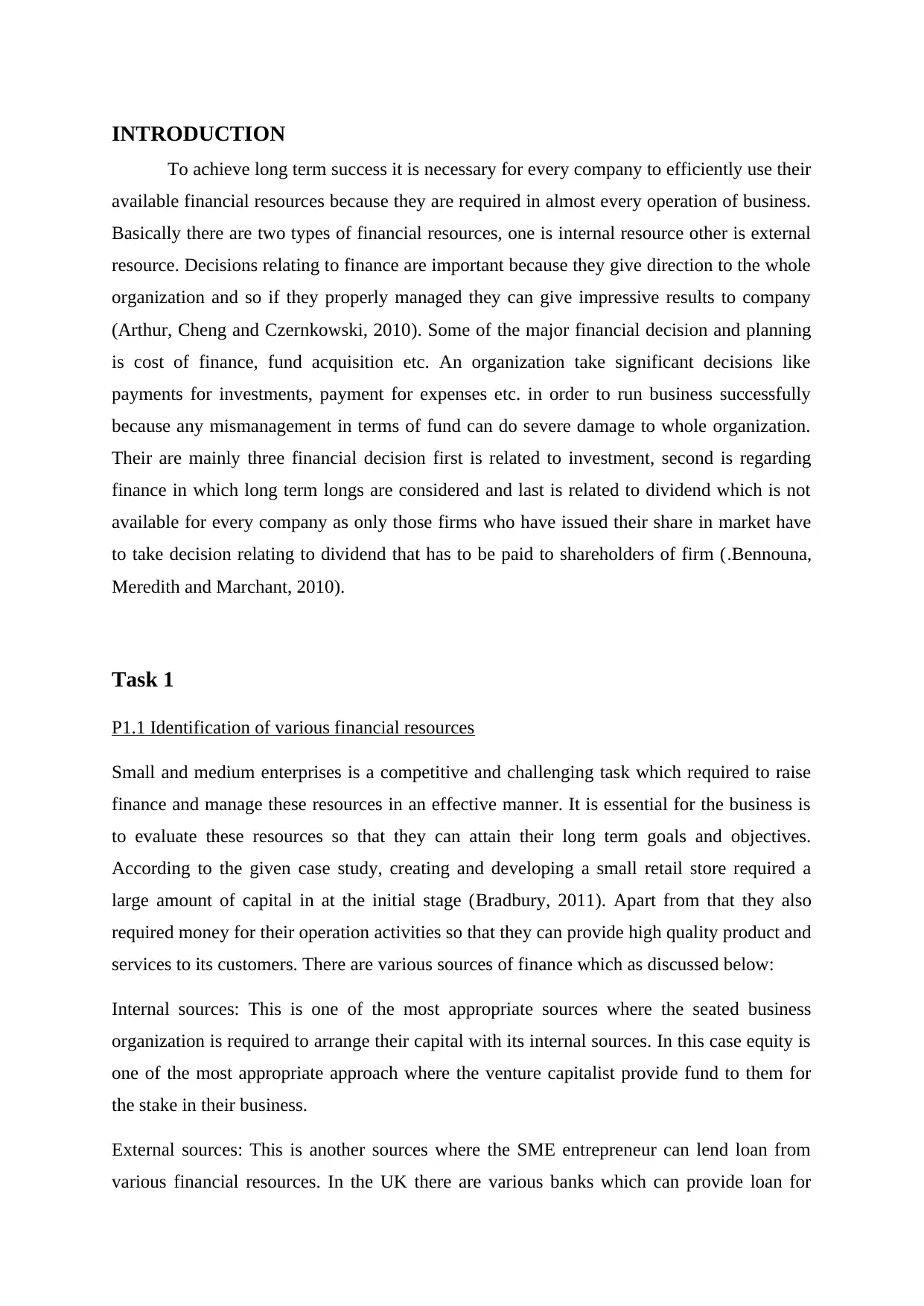
INTRODUCTION
To achieve long term success it is necessary for every company to efficiently use their
available financial resources because they are required in almost every operation of business.
Basically there are two types of financial resources, one is internal resource other is external
resource. Decisions relating to finance are important because they give direction to the whole
organization and so if they properly managed they can give impressive results to company
(Arthur, Cheng and Czernkowski, 2010). Some of the major financial decision and planning
is cost of finance, fund acquisition etc. An organization take significant decisions like
payments for investments, payment for expenses etc. in order to run business successfully
because any mismanagement in terms of fund can do severe damage to whole organization.
Their are mainly three financial decision first is related to investment, second is regarding
finance in which long term longs are considered and last is related to dividend which is not
available for every company as only those firms who have issued their share in market have
to take decision relating to dividend that has to be paid to shareholders of firm (.Bennouna,
Meredith and Marchant, 2010).
Task 1
P1.1 Identification of various financial resources
Small and medium enterprises is a competitive and challenging task which required to raise
finance and manage these resources in an effective manner. It is essential for the business is
to evaluate these resources so that they can attain their long term goals and objectives.
According to the given case study, creating and developing a small retail store required a
large amount of capital in at the initial stage (Bradbury, 2011). Apart from that they also
required money for their operation activities so that they can provide high quality product and
services to its customers. There are various sources of finance which as discussed below:
Internal sources: This is one of the most appropriate sources where the seated business
organization is required to arrange their capital with its internal sources. In this case equity is
one of the most appropriate approach where the venture capitalist provide fund to them for
the stake in their business.
External sources: This is another sources where the SME entrepreneur can lend loan from
various financial resources. In the UK there are various banks which can provide loan for
To achieve long term success it is necessary for every company to efficiently use their
available financial resources because they are required in almost every operation of business.
Basically there are two types of financial resources, one is internal resource other is external
resource. Decisions relating to finance are important because they give direction to the whole
organization and so if they properly managed they can give impressive results to company
(Arthur, Cheng and Czernkowski, 2010). Some of the major financial decision and planning
is cost of finance, fund acquisition etc. An organization take significant decisions like
payments for investments, payment for expenses etc. in order to run business successfully
because any mismanagement in terms of fund can do severe damage to whole organization.
Their are mainly three financial decision first is related to investment, second is regarding
finance in which long term longs are considered and last is related to dividend which is not
available for every company as only those firms who have issued their share in market have
to take decision relating to dividend that has to be paid to shareholders of firm (.Bennouna,
Meredith and Marchant, 2010).
Task 1
P1.1 Identification of various financial resources
Small and medium enterprises is a competitive and challenging task which required to raise
finance and manage these resources in an effective manner. It is essential for the business is
to evaluate these resources so that they can attain their long term goals and objectives.
According to the given case study, creating and developing a small retail store required a
large amount of capital in at the initial stage (Bradbury, 2011). Apart from that they also
required money for their operation activities so that they can provide high quality product and
services to its customers. There are various sources of finance which as discussed below:
Internal sources: This is one of the most appropriate sources where the seated business
organization is required to arrange their capital with its internal sources. In this case equity is
one of the most appropriate approach where the venture capitalist provide fund to them for
the stake in their business.
External sources: This is another sources where the SME entrepreneur can lend loan from
various financial resources. In the UK there are various banks which can provide loan for
You're viewing a preview
Unlock full access by subscribing today!
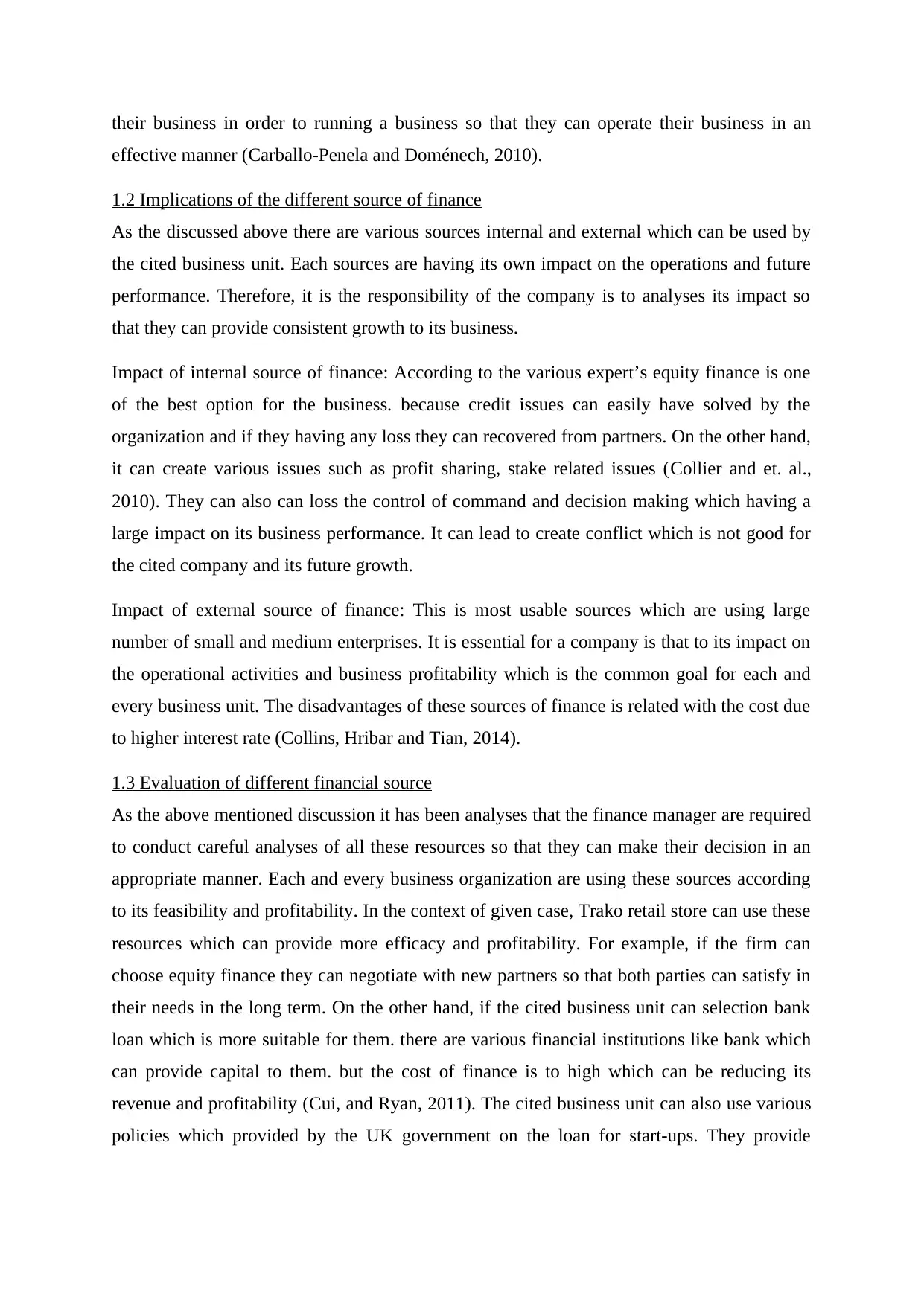
their business in order to running a business so that they can operate their business in an
effective manner (Carballo-Penela and Doménech, 2010).
1.2 Implications of the different source of finance
As the discussed above there are various sources internal and external which can be used by
the cited business unit. Each sources are having its own impact on the operations and future
performance. Therefore, it is the responsibility of the company is to analyses its impact so
that they can provide consistent growth to its business.
Impact of internal source of finance: According to the various expert’s equity finance is one
of the best option for the business. because credit issues can easily have solved by the
organization and if they having any loss they can recovered from partners. On the other hand,
it can create various issues such as profit sharing, stake related issues (Collier and et. al.,
2010). They can also can loss the control of command and decision making which having a
large impact on its business performance. It can lead to create conflict which is not good for
the cited company and its future growth.
Impact of external source of finance: This is most usable sources which are using large
number of small and medium enterprises. It is essential for a company is that to its impact on
the operational activities and business profitability which is the common goal for each and
every business unit. The disadvantages of these sources of finance is related with the cost due
to higher interest rate (Collins, Hribar and Tian, 2014).
1.3 Evaluation of different financial source
As the above mentioned discussion it has been analyses that the finance manager are required
to conduct careful analyses of all these resources so that they can make their decision in an
appropriate manner. Each and every business organization are using these sources according
to its feasibility and profitability. In the context of given case, Trako retail store can use these
resources which can provide more efficacy and profitability. For example, if the firm can
choose equity finance they can negotiate with new partners so that both parties can satisfy in
their needs in the long term. On the other hand, if the cited business unit can selection bank
loan which is more suitable for them. there are various financial institutions like bank which
can provide capital to them. but the cost of finance is to high which can be reducing its
revenue and profitability (Cui, and Ryan, 2011). The cited business unit can also use various
policies which provided by the UK government on the loan for start-ups. They provide
effective manner (Carballo-Penela and Doménech, 2010).
1.2 Implications of the different source of finance
As the discussed above there are various sources internal and external which can be used by
the cited business unit. Each sources are having its own impact on the operations and future
performance. Therefore, it is the responsibility of the company is to analyses its impact so
that they can provide consistent growth to its business.
Impact of internal source of finance: According to the various expert’s equity finance is one
of the best option for the business. because credit issues can easily have solved by the
organization and if they having any loss they can recovered from partners. On the other hand,
it can create various issues such as profit sharing, stake related issues (Collier and et. al.,
2010). They can also can loss the control of command and decision making which having a
large impact on its business performance. It can lead to create conflict which is not good for
the cited company and its future growth.
Impact of external source of finance: This is most usable sources which are using large
number of small and medium enterprises. It is essential for a company is that to its impact on
the operational activities and business profitability which is the common goal for each and
every business unit. The disadvantages of these sources of finance is related with the cost due
to higher interest rate (Collins, Hribar and Tian, 2014).
1.3 Evaluation of different financial source
As the above mentioned discussion it has been analyses that the finance manager are required
to conduct careful analyses of all these resources so that they can make their decision in an
appropriate manner. Each and every business organization are using these sources according
to its feasibility and profitability. In the context of given case, Trako retail store can use these
resources which can provide more efficacy and profitability. For example, if the firm can
choose equity finance they can negotiate with new partners so that both parties can satisfy in
their needs in the long term. On the other hand, if the cited business unit can selection bank
loan which is more suitable for them. there are various financial institutions like bank which
can provide capital to them. but the cost of finance is to high which can be reducing its
revenue and profitability (Cui, and Ryan, 2011). The cited business unit can also use various
policies which provided by the UK government on the loan for start-ups. They provide
Paraphrase This Document
Need a fresh take? Get an instant paraphrase of this document with our AI Paraphraser
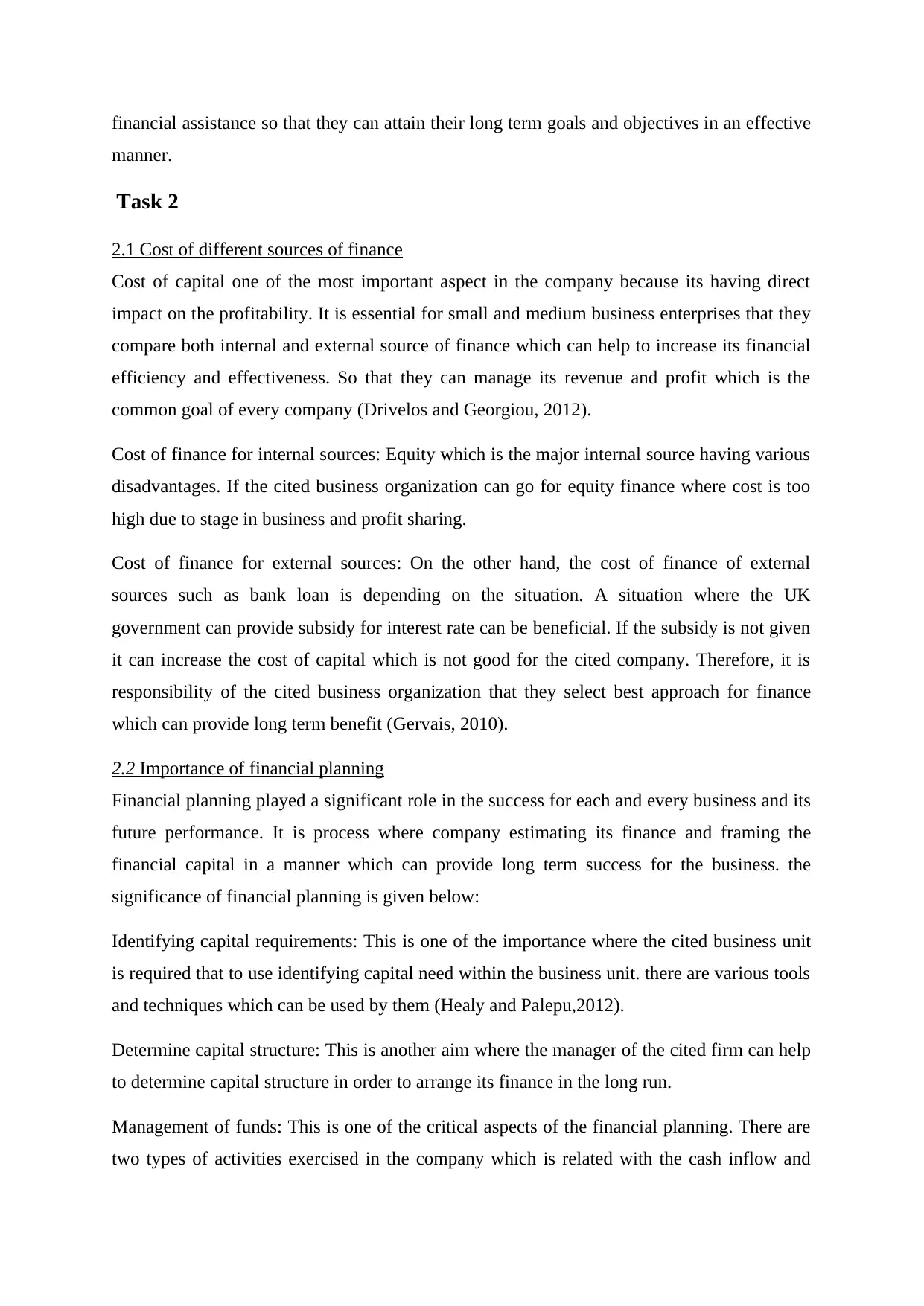
financial assistance so that they can attain their long term goals and objectives in an effective
manner.
Task 2
2.1 Cost of different sources of finance
Cost of capital one of the most important aspect in the company because its having direct
impact on the profitability. It is essential for small and medium business enterprises that they
compare both internal and external source of finance which can help to increase its financial
efficiency and effectiveness. So that they can manage its revenue and profit which is the
common goal of every company (Drivelos and Georgiou, 2012).
Cost of finance for internal sources: Equity which is the major internal source having various
disadvantages. If the cited business organization can go for equity finance where cost is too
high due to stage in business and profit sharing.
Cost of finance for external sources: On the other hand, the cost of finance of external
sources such as bank loan is depending on the situation. A situation where the UK
government can provide subsidy for interest rate can be beneficial. If the subsidy is not given
it can increase the cost of capital which is not good for the cited company. Therefore, it is
responsibility of the cited business organization that they select best approach for finance
which can provide long term benefit (Gervais, 2010).
2.2 Importance of financial planning
Financial planning played a significant role in the success for each and every business and its
future performance. It is process where company estimating its finance and framing the
financial capital in a manner which can provide long term success for the business. the
significance of financial planning is given below:
Identifying capital requirements: This is one of the importance where the cited business unit
is required that to use identifying capital need within the business unit. there are various tools
and techniques which can be used by them (Healy and Palepu,2012).
Determine capital structure: This is another aim where the manager of the cited firm can help
to determine capital structure in order to arrange its finance in the long run.
Management of funds: This is one of the critical aspects of the financial planning. There are
two types of activities exercised in the company which is related with the cash inflow and
manner.
Task 2
2.1 Cost of different sources of finance
Cost of capital one of the most important aspect in the company because its having direct
impact on the profitability. It is essential for small and medium business enterprises that they
compare both internal and external source of finance which can help to increase its financial
efficiency and effectiveness. So that they can manage its revenue and profit which is the
common goal of every company (Drivelos and Georgiou, 2012).
Cost of finance for internal sources: Equity which is the major internal source having various
disadvantages. If the cited business organization can go for equity finance where cost is too
high due to stage in business and profit sharing.
Cost of finance for external sources: On the other hand, the cost of finance of external
sources such as bank loan is depending on the situation. A situation where the UK
government can provide subsidy for interest rate can be beneficial. If the subsidy is not given
it can increase the cost of capital which is not good for the cited company. Therefore, it is
responsibility of the cited business organization that they select best approach for finance
which can provide long term benefit (Gervais, 2010).
2.2 Importance of financial planning
Financial planning played a significant role in the success for each and every business and its
future performance. It is process where company estimating its finance and framing the
financial capital in a manner which can provide long term success for the business. the
significance of financial planning is given below:
Identifying capital requirements: This is one of the importance where the cited business unit
is required that to use identifying capital need within the business unit. there are various tools
and techniques which can be used by them (Healy and Palepu,2012).
Determine capital structure: This is another aim where the manager of the cited firm can help
to determine capital structure in order to arrange its finance in the long run.
Management of funds: This is one of the critical aspects of the financial planning. There are
two types of activities exercised in the company which is related with the cash inflow and
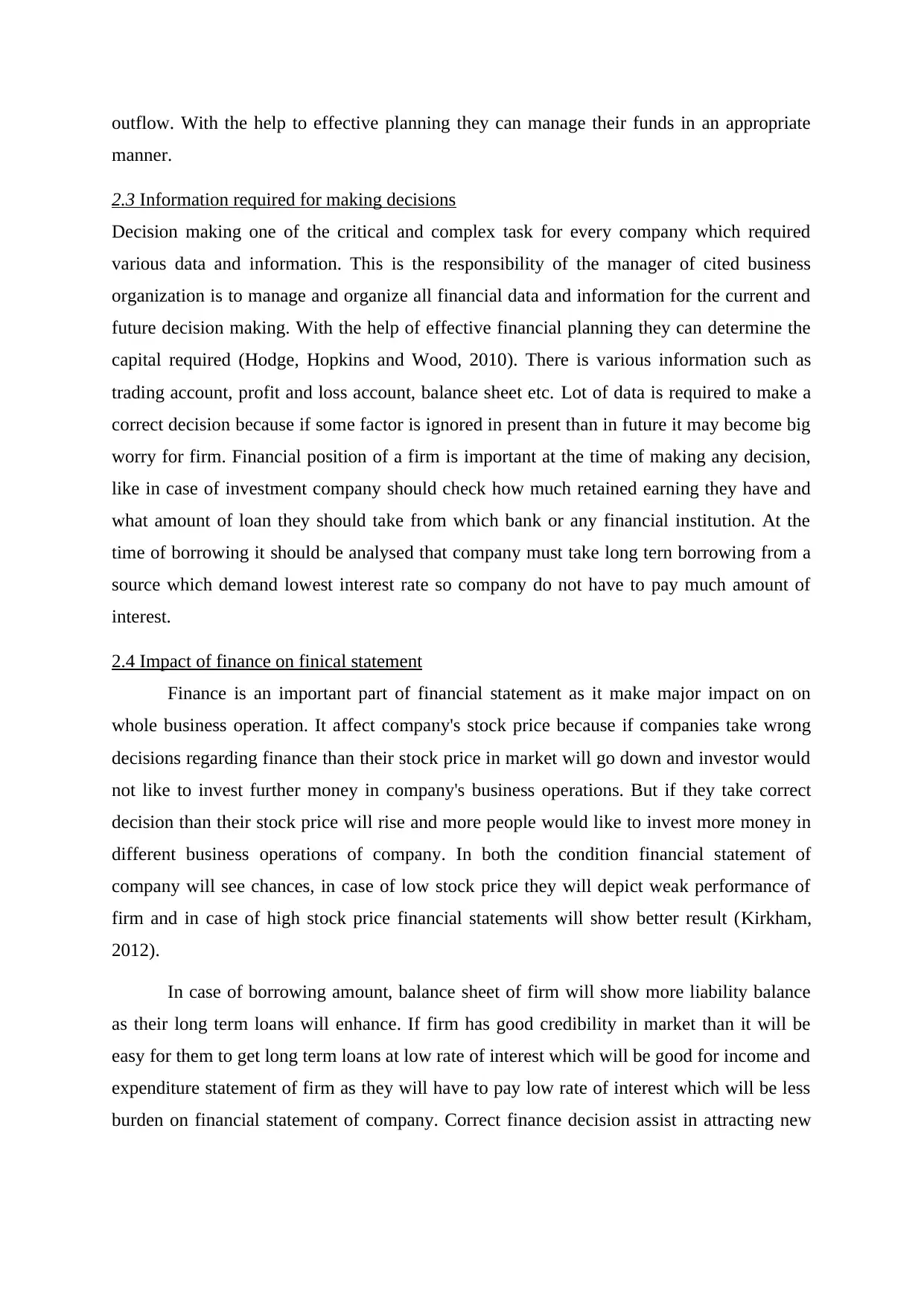
outflow. With the help to effective planning they can manage their funds in an appropriate
manner.
2.3 Information required for making decisions
Decision making one of the critical and complex task for every company which required
various data and information. This is the responsibility of the manager of cited business
organization is to manage and organize all financial data and information for the current and
future decision making. With the help of effective financial planning they can determine the
capital required (Hodge, Hopkins and Wood, 2010). There is various information such as
trading account, profit and loss account, balance sheet etc. Lot of data is required to make a
correct decision because if some factor is ignored in present than in future it may become big
worry for firm. Financial position of a firm is important at the time of making any decision,
like in case of investment company should check how much retained earning they have and
what amount of loan they should take from which bank or any financial institution. At the
time of borrowing it should be analysed that company must take long tern borrowing from a
source which demand lowest interest rate so company do not have to pay much amount of
interest.
2.4 Impact of finance on finical statement
Finance is an important part of financial statement as it make major impact on on
whole business operation. It affect company's stock price because if companies take wrong
decisions regarding finance than their stock price in market will go down and investor would
not like to invest further money in company's business operations. But if they take correct
decision than their stock price will rise and more people would like to invest more money in
different business operations of company. In both the condition financial statement of
company will see chances, in case of low stock price they will depict weak performance of
firm and in case of high stock price financial statements will show better result (Kirkham,
2012).
In case of borrowing amount, balance sheet of firm will show more liability balance
as their long term loans will enhance. If firm has good credibility in market than it will be
easy for them to get long term loans at low rate of interest which will be good for income and
expenditure statement of firm as they will have to pay low rate of interest which will be less
burden on financial statement of company. Correct finance decision assist in attracting new
manner.
2.3 Information required for making decisions
Decision making one of the critical and complex task for every company which required
various data and information. This is the responsibility of the manager of cited business
organization is to manage and organize all financial data and information for the current and
future decision making. With the help of effective financial planning they can determine the
capital required (Hodge, Hopkins and Wood, 2010). There is various information such as
trading account, profit and loss account, balance sheet etc. Lot of data is required to make a
correct decision because if some factor is ignored in present than in future it may become big
worry for firm. Financial position of a firm is important at the time of making any decision,
like in case of investment company should check how much retained earning they have and
what amount of loan they should take from which bank or any financial institution. At the
time of borrowing it should be analysed that company must take long tern borrowing from a
source which demand lowest interest rate so company do not have to pay much amount of
interest.
2.4 Impact of finance on finical statement
Finance is an important part of financial statement as it make major impact on on
whole business operation. It affect company's stock price because if companies take wrong
decisions regarding finance than their stock price in market will go down and investor would
not like to invest further money in company's business operations. But if they take correct
decision than their stock price will rise and more people would like to invest more money in
different business operations of company. In both the condition financial statement of
company will see chances, in case of low stock price they will depict weak performance of
firm and in case of high stock price financial statements will show better result (Kirkham,
2012).
In case of borrowing amount, balance sheet of firm will show more liability balance
as their long term loans will enhance. If firm has good credibility in market than it will be
easy for them to get long term loans at low rate of interest which will be good for income and
expenditure statement of firm as they will have to pay low rate of interest which will be less
burden on financial statement of company. Correct finance decision assist in attracting new
You're viewing a preview
Unlock full access by subscribing today!
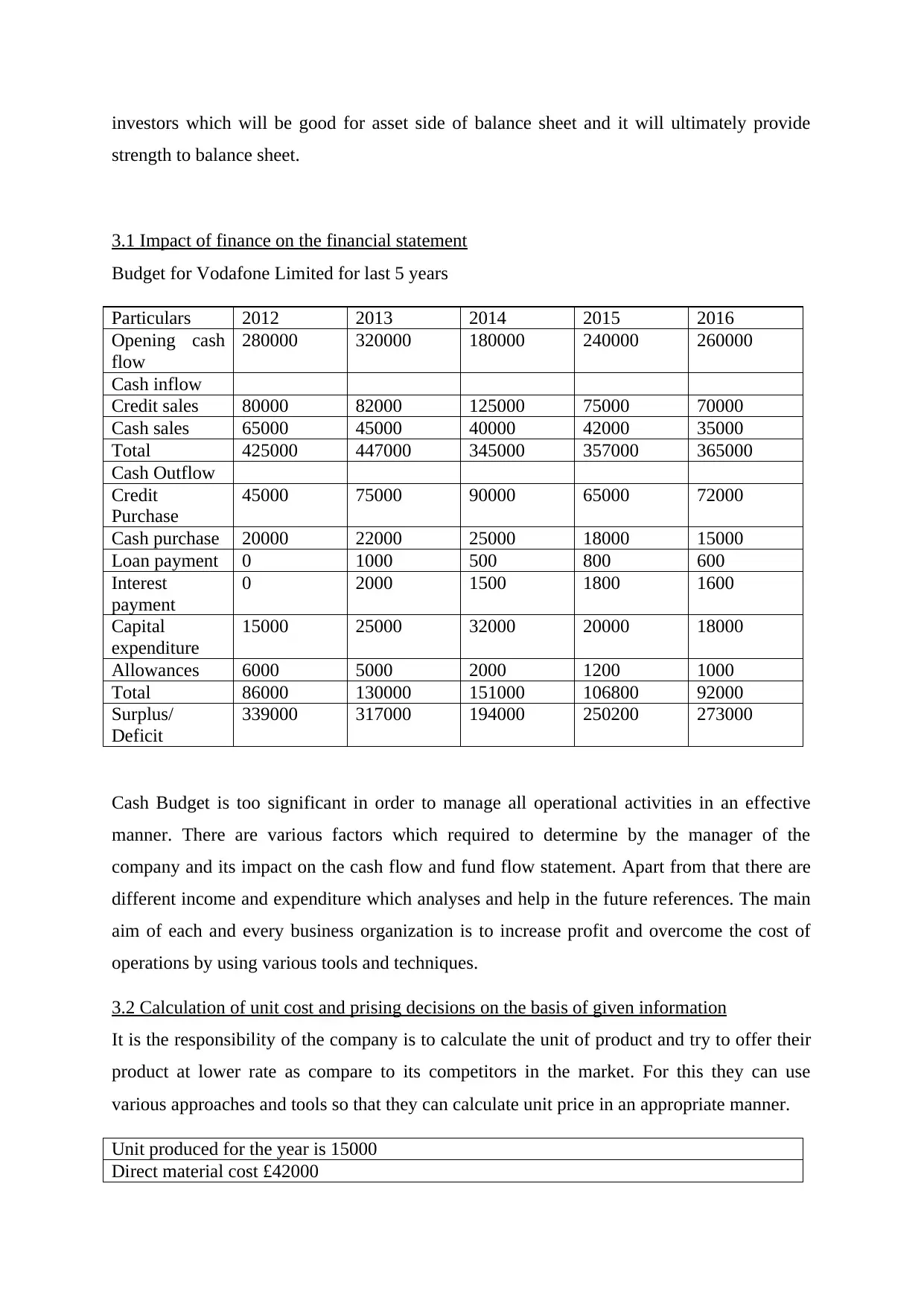
investors which will be good for asset side of balance sheet and it will ultimately provide
strength to balance sheet.
3.1 Impact of finance on the financial statement
Budget for Vodafone Limited for last 5 years
Particulars 2012 2013 2014 2015 2016
Opening cash
flow
280000 320000 180000 240000 260000
Cash inflow
Credit sales 80000 82000 125000 75000 70000
Cash sales 65000 45000 40000 42000 35000
Total 425000 447000 345000 357000 365000
Cash Outflow
Credit
Purchase
45000 75000 90000 65000 72000
Cash purchase 20000 22000 25000 18000 15000
Loan payment 0 1000 500 800 600
Interest
payment
0 2000 1500 1800 1600
Capital
expenditure
15000 25000 32000 20000 18000
Allowances 6000 5000 2000 1200 1000
Total 86000 130000 151000 106800 92000
Surplus/
Deficit
339000 317000 194000 250200 273000
Cash Budget is too significant in order to manage all operational activities in an effective
manner. There are various factors which required to determine by the manager of the
company and its impact on the cash flow and fund flow statement. Apart from that there are
different income and expenditure which analyses and help in the future references. The main
aim of each and every business organization is to increase profit and overcome the cost of
operations by using various tools and techniques.
3.2 Calculation of unit cost and prising decisions on the basis of given information
It is the responsibility of the company is to calculate the unit of product and try to offer their
product at lower rate as compare to its competitors in the market. For this they can use
various approaches and tools so that they can calculate unit price in an appropriate manner.
Unit produced for the year is 15000
Direct material cost £42000
strength to balance sheet.
3.1 Impact of finance on the financial statement
Budget for Vodafone Limited for last 5 years
Particulars 2012 2013 2014 2015 2016
Opening cash
flow
280000 320000 180000 240000 260000
Cash inflow
Credit sales 80000 82000 125000 75000 70000
Cash sales 65000 45000 40000 42000 35000
Total 425000 447000 345000 357000 365000
Cash Outflow
Credit
Purchase
45000 75000 90000 65000 72000
Cash purchase 20000 22000 25000 18000 15000
Loan payment 0 1000 500 800 600
Interest
payment
0 2000 1500 1800 1600
Capital
expenditure
15000 25000 32000 20000 18000
Allowances 6000 5000 2000 1200 1000
Total 86000 130000 151000 106800 92000
Surplus/
Deficit
339000 317000 194000 250200 273000
Cash Budget is too significant in order to manage all operational activities in an effective
manner. There are various factors which required to determine by the manager of the
company and its impact on the cash flow and fund flow statement. Apart from that there are
different income and expenditure which analyses and help in the future references. The main
aim of each and every business organization is to increase profit and overcome the cost of
operations by using various tools and techniques.
3.2 Calculation of unit cost and prising decisions on the basis of given information
It is the responsibility of the company is to calculate the unit of product and try to offer their
product at lower rate as compare to its competitors in the market. For this they can use
various approaches and tools so that they can calculate unit price in an appropriate manner.
Unit produced for the year is 15000
Direct material cost £42000
Paraphrase This Document
Need a fresh take? Get an instant paraphrase of this document with our AI Paraphraser
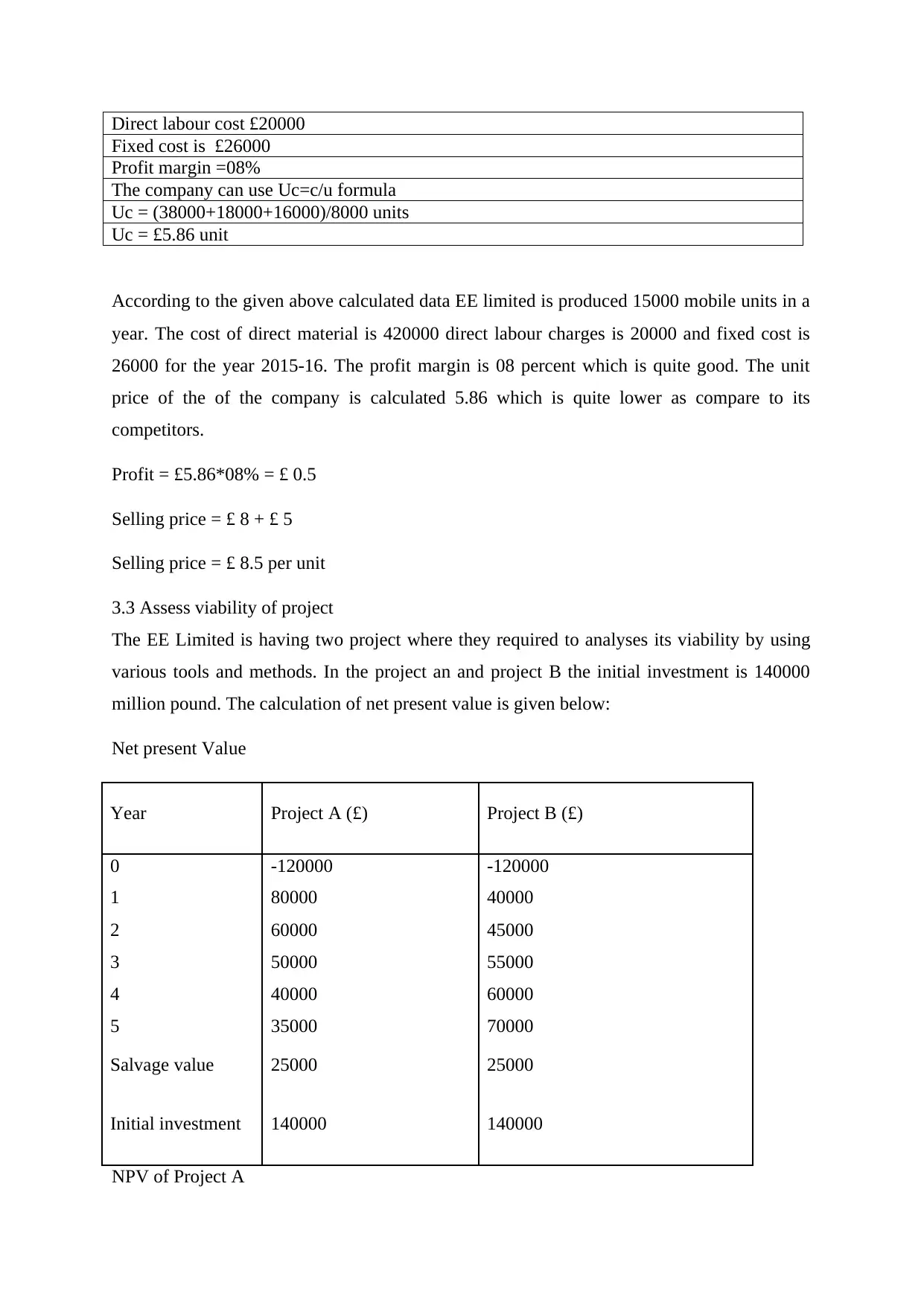
Direct labour cost £20000
Fixed cost is £26000
Profit margin =08%
The company can use Uc=c/u formula
Uc = (38000+18000+16000)/8000 units
Uc = £5.86 unit
According to the given above calculated data EE limited is produced 15000 mobile units in a
year. The cost of direct material is 420000 direct labour charges is 20000 and fixed cost is
26000 for the year 2015-16. The profit margin is 08 percent which is quite good. The unit
price of the of the company is calculated 5.86 which is quite lower as compare to its
competitors.
Profit = £5.86*08% = £ 0.5
Selling price = £ 8 + £ 5
Selling price = £ 8.5 per unit
3.3 Assess viability of project
The EE Limited is having two project where they required to analyses its viability by using
various tools and methods. In the project an and project B the initial investment is 140000
million pound. The calculation of net present value is given below:
Net present Value
Year Project A (£) Project B (£)
0 -120000 -120000
1 80000 40000
2 60000 45000
3 50000 55000
4 40000 60000
5 35000 70000
Salvage value 25000 25000
Initial investment 140000 140000
NPV of Project A
Fixed cost is £26000
Profit margin =08%
The company can use Uc=c/u formula
Uc = (38000+18000+16000)/8000 units
Uc = £5.86 unit
According to the given above calculated data EE limited is produced 15000 mobile units in a
year. The cost of direct material is 420000 direct labour charges is 20000 and fixed cost is
26000 for the year 2015-16. The profit margin is 08 percent which is quite good. The unit
price of the of the company is calculated 5.86 which is quite lower as compare to its
competitors.
Profit = £5.86*08% = £ 0.5
Selling price = £ 8 + £ 5
Selling price = £ 8.5 per unit
3.3 Assess viability of project
The EE Limited is having two project where they required to analyses its viability by using
various tools and methods. In the project an and project B the initial investment is 140000
million pound. The calculation of net present value is given below:
Net present Value
Year Project A (£) Project B (£)
0 -120000 -120000
1 80000 40000
2 60000 45000
3 50000 55000
4 40000 60000
5 35000 70000
Salvage value 25000 25000
Initial investment 140000 140000
NPV of Project A
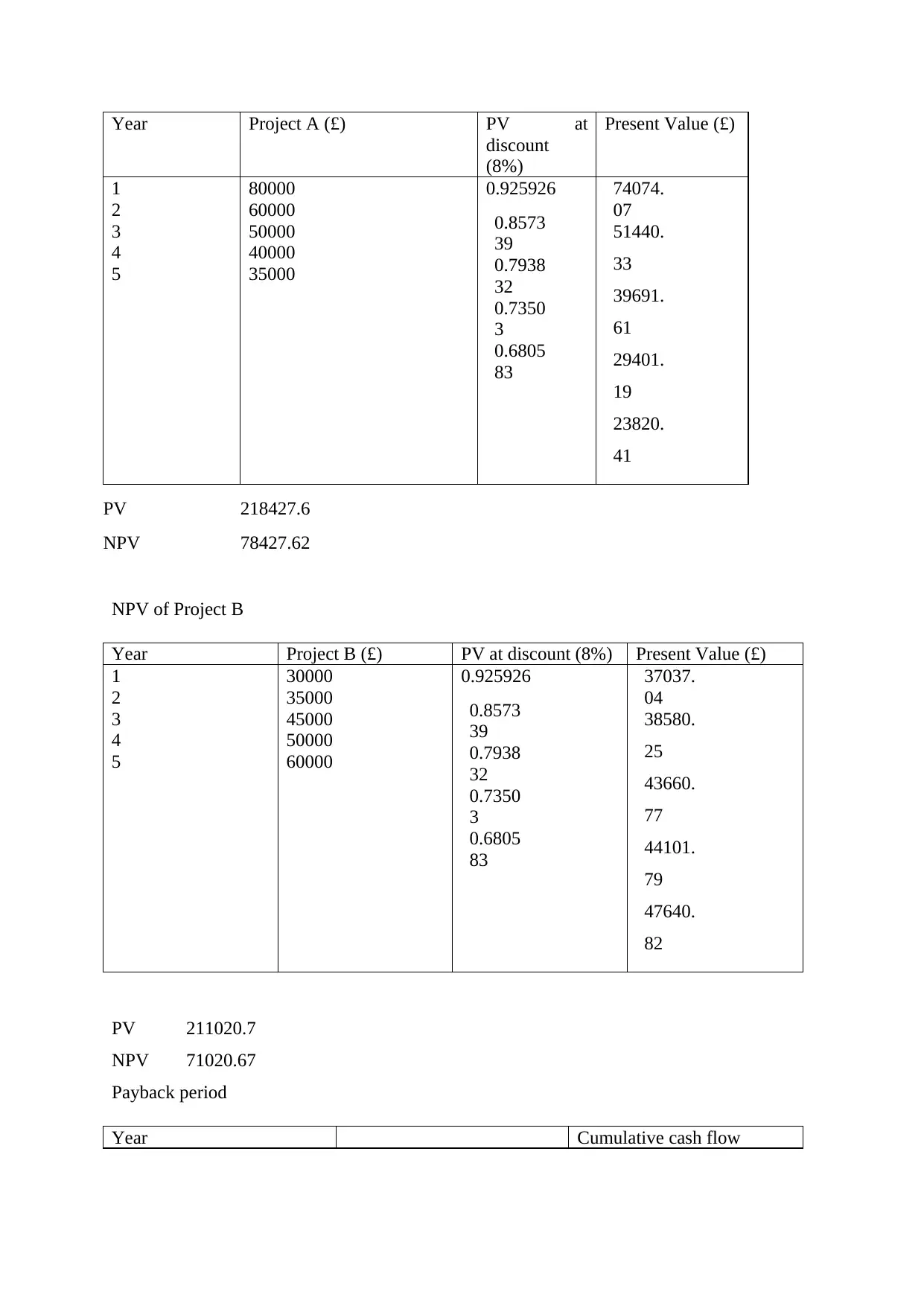
Year Project A (£) PV at
discount
(8%)
Present Value (£)
1
2
3
4
5
80000
60000
50000
40000
35000
0.925926
0.8573
39
0.7938
32
0.7350
3
0.6805
83
74074.
07
51440.
33
39691.
61
29401.
19
23820.
41
PV 218427.6
NPV 78427.62
NPV of Project B
Year Project B (£) PV at discount (8%) Present Value (£)
1
2
3
4
5
30000
35000
45000
50000
60000
0.925926
0.8573
39
0.7938
32
0.7350
3
0.6805
83
37037.
04
38580.
25
43660.
77
44101.
79
47640.
82
PV 211020.7
NPV 71020.67
Payback period
Year Cumulative cash flow
discount
(8%)
Present Value (£)
1
2
3
4
5
80000
60000
50000
40000
35000
0.925926
0.8573
39
0.7938
32
0.7350
3
0.6805
83
74074.
07
51440.
33
39691.
61
29401.
19
23820.
41
PV 218427.6
NPV 78427.62
NPV of Project B
Year Project B (£) PV at discount (8%) Present Value (£)
1
2
3
4
5
30000
35000
45000
50000
60000
0.925926
0.8573
39
0.7938
32
0.7350
3
0.6805
83
37037.
04
38580.
25
43660.
77
44101.
79
47640.
82
PV 211020.7
NPV 71020.67
Payback period
Year Cumulative cash flow
You're viewing a preview
Unlock full access by subscribing today!
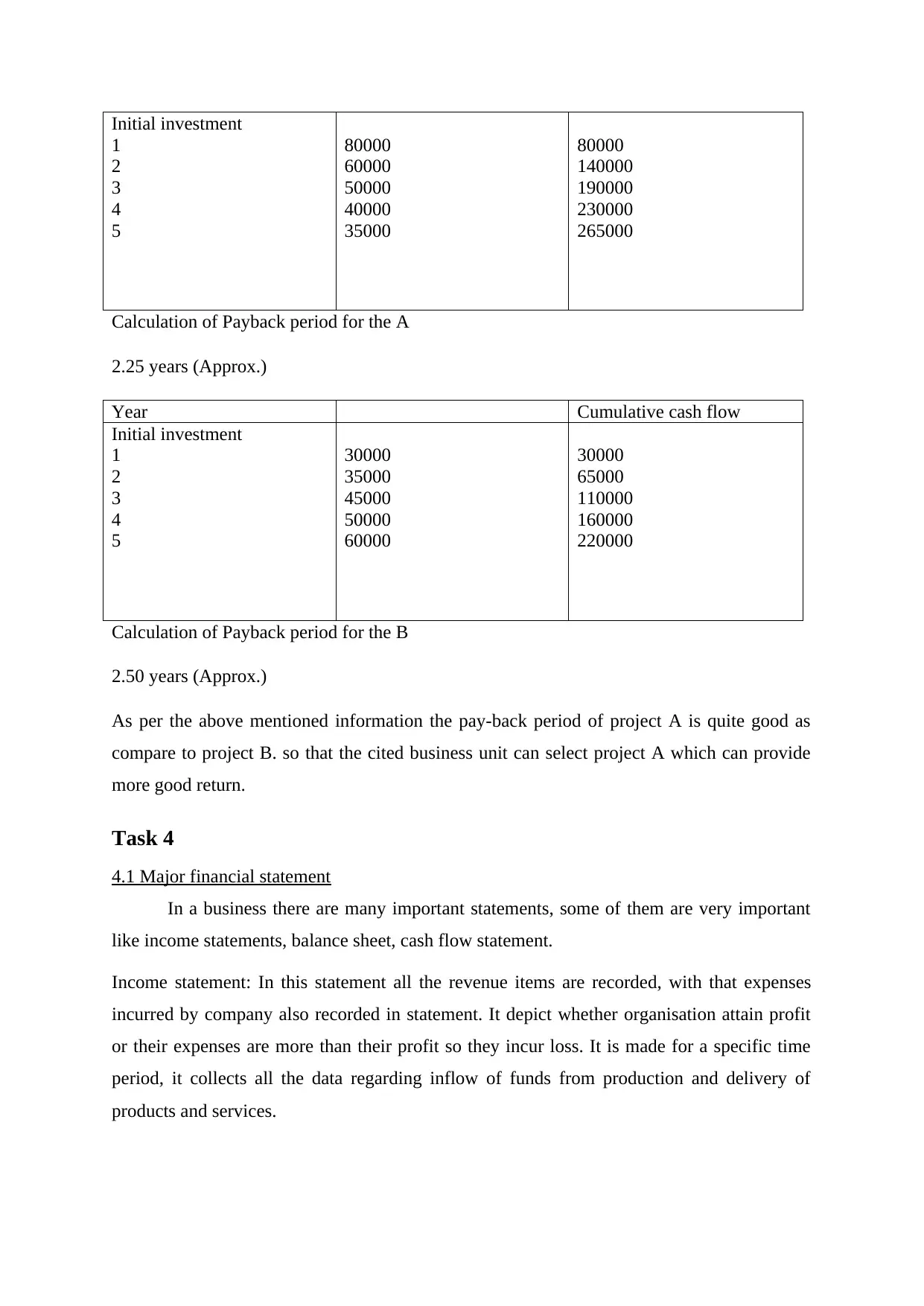
Initial investment
1
2
3
4
5
80000
60000
50000
40000
35000
80000
140000
190000
230000
265000
Calculation of Payback period for the A
2.25 years (Approx.)
Year Cumulative cash flow
Initial investment
1
2
3
4
5
30000
35000
45000
50000
60000
30000
65000
110000
160000
220000
Calculation of Payback period for the B
2.50 years (Approx.)
As per the above mentioned information the pay-back period of project A is quite good as
compare to project B. so that the cited business unit can select project A which can provide
more good return.
Task 4
4.1 Major financial statement
In a business there are many important statements, some of them are very important
like income statements, balance sheet, cash flow statement.
Income statement: In this statement all the revenue items are recorded, with that expenses
incurred by company also recorded in statement. It depict whether organisation attain profit
or their expenses are more than their profit so they incur loss. It is made for a specific time
period, it collects all the data regarding inflow of funds from production and delivery of
products and services.
1
2
3
4
5
80000
60000
50000
40000
35000
80000
140000
190000
230000
265000
Calculation of Payback period for the A
2.25 years (Approx.)
Year Cumulative cash flow
Initial investment
1
2
3
4
5
30000
35000
45000
50000
60000
30000
65000
110000
160000
220000
Calculation of Payback period for the B
2.50 years (Approx.)
As per the above mentioned information the pay-back period of project A is quite good as
compare to project B. so that the cited business unit can select project A which can provide
more good return.
Task 4
4.1 Major financial statement
In a business there are many important statements, some of them are very important
like income statements, balance sheet, cash flow statement.
Income statement: In this statement all the revenue items are recorded, with that expenses
incurred by company also recorded in statement. It depict whether organisation attain profit
or their expenses are more than their profit so they incur loss. It is made for a specific time
period, it collects all the data regarding inflow of funds from production and delivery of
products and services.
Paraphrase This Document
Need a fresh take? Get an instant paraphrase of this document with our AI Paraphraser
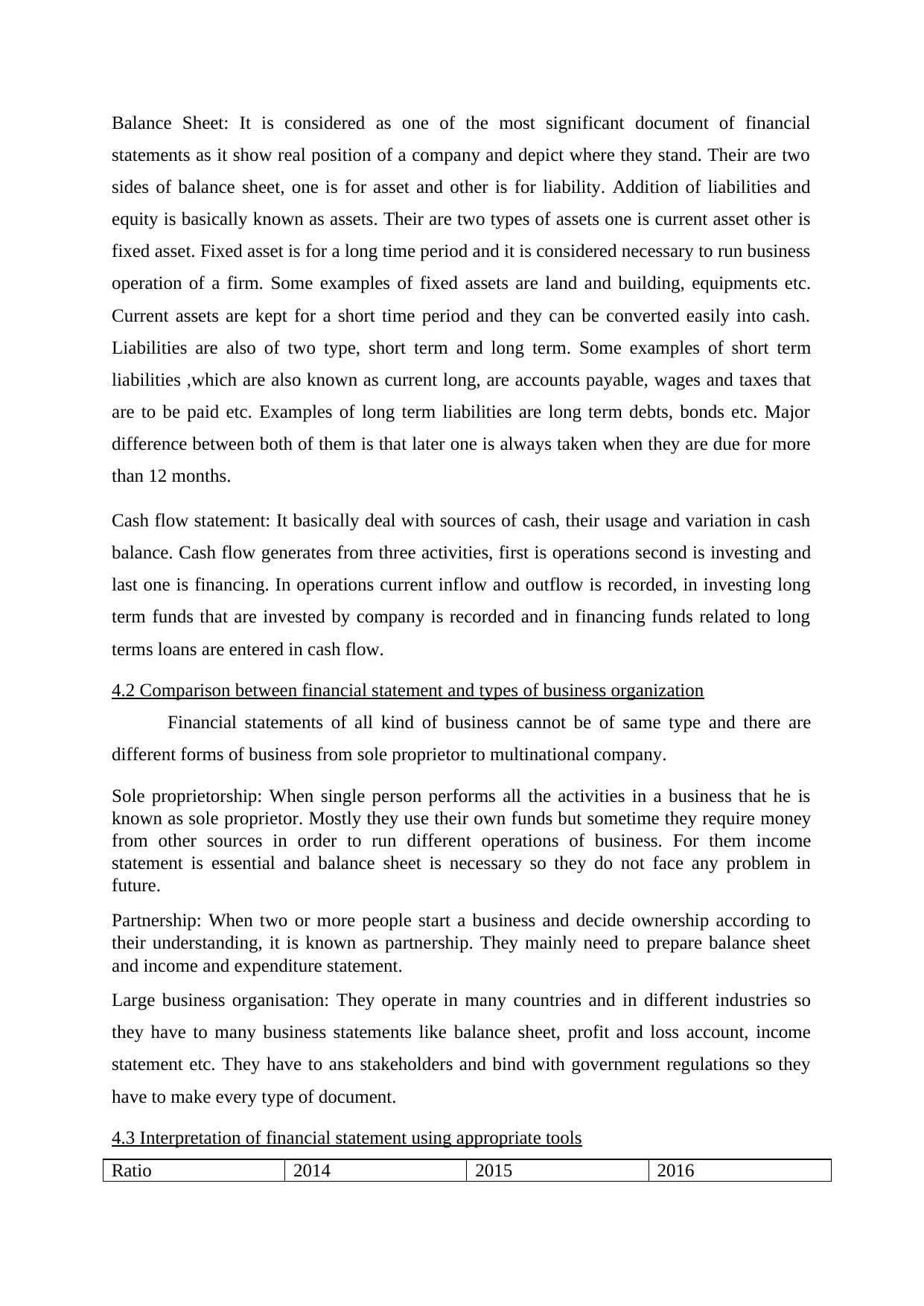
Balance Sheet: It is considered as one of the most significant document of financial
statements as it show real position of a company and depict where they stand. Their are two
sides of balance sheet, one is for asset and other is for liability. Addition of liabilities and
equity is basically known as assets. Their are two types of assets one is current asset other is
fixed asset. Fixed asset is for a long time period and it is considered necessary to run business
operation of a firm. Some examples of fixed assets are land and building, equipments etc.
Current assets are kept for a short time period and they can be converted easily into cash.
Liabilities are also of two type, short term and long term. Some examples of short term
liabilities ,which are also known as current long, are accounts payable, wages and taxes that
are to be paid etc. Examples of long term liabilities are long term debts, bonds etc. Major
difference between both of them is that later one is always taken when they are due for more
than 12 months.
Cash flow statement: It basically deal with sources of cash, their usage and variation in cash
balance. Cash flow generates from three activities, first is operations second is investing and
last one is financing. In operations current inflow and outflow is recorded, in investing long
term funds that are invested by company is recorded and in financing funds related to long
terms loans are entered in cash flow.
4.2 Comparison between financial statement and types of business organization
Financial statements of all kind of business cannot be of same type and there are
different forms of business from sole proprietor to multinational company.
Sole proprietorship: When single person performs all the activities in a business that he is
known as sole proprietor. Mostly they use their own funds but sometime they require money
from other sources in order to run different operations of business. For them income
statement is essential and balance sheet is necessary so they do not face any problem in
future.
Partnership: When two or more people start a business and decide ownership according to
their understanding, it is known as partnership. They mainly need to prepare balance sheet
and income and expenditure statement.
Large business organisation: They operate in many countries and in different industries so
they have to many business statements like balance sheet, profit and loss account, income
statement etc. They have to ans stakeholders and bind with government regulations so they
have to make every type of document.
4.3 Interpretation of financial statement using appropriate tools
Ratio 2014 2015 2016
statements as it show real position of a company and depict where they stand. Their are two
sides of balance sheet, one is for asset and other is for liability. Addition of liabilities and
equity is basically known as assets. Their are two types of assets one is current asset other is
fixed asset. Fixed asset is for a long time period and it is considered necessary to run business
operation of a firm. Some examples of fixed assets are land and building, equipments etc.
Current assets are kept for a short time period and they can be converted easily into cash.
Liabilities are also of two type, short term and long term. Some examples of short term
liabilities ,which are also known as current long, are accounts payable, wages and taxes that
are to be paid etc. Examples of long term liabilities are long term debts, bonds etc. Major
difference between both of them is that later one is always taken when they are due for more
than 12 months.
Cash flow statement: It basically deal with sources of cash, their usage and variation in cash
balance. Cash flow generates from three activities, first is operations second is investing and
last one is financing. In operations current inflow and outflow is recorded, in investing long
term funds that are invested by company is recorded and in financing funds related to long
terms loans are entered in cash flow.
4.2 Comparison between financial statement and types of business organization
Financial statements of all kind of business cannot be of same type and there are
different forms of business from sole proprietor to multinational company.
Sole proprietorship: When single person performs all the activities in a business that he is
known as sole proprietor. Mostly they use their own funds but sometime they require money
from other sources in order to run different operations of business. For them income
statement is essential and balance sheet is necessary so they do not face any problem in
future.
Partnership: When two or more people start a business and decide ownership according to
their understanding, it is known as partnership. They mainly need to prepare balance sheet
and income and expenditure statement.
Large business organisation: They operate in many countries and in different industries so
they have to many business statements like balance sheet, profit and loss account, income
statement etc. They have to ans stakeholders and bind with government regulations so they
have to make every type of document.
4.3 Interpretation of financial statement using appropriate tools
Ratio 2014 2015 2016
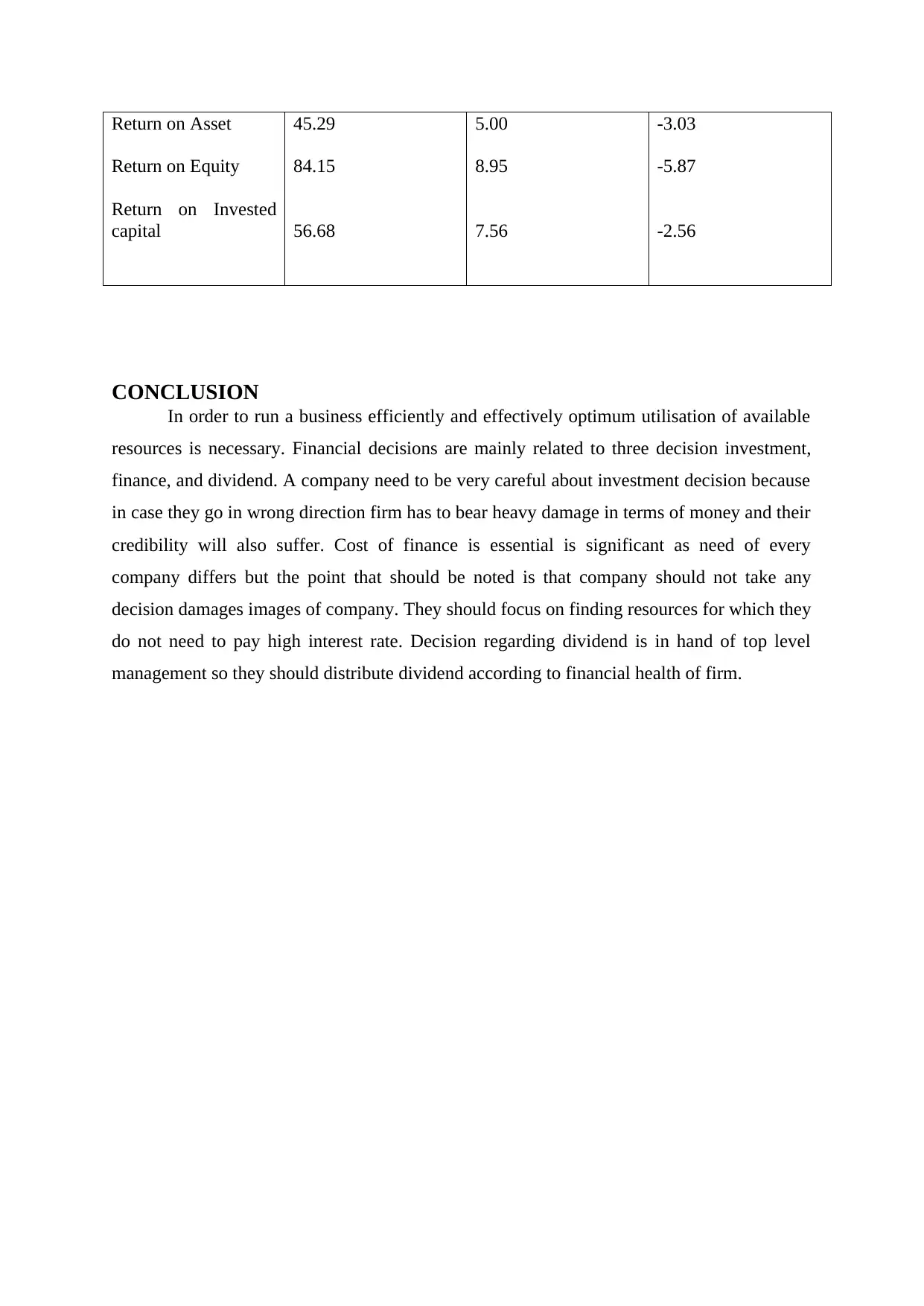
Return on Asset
Return on Equity
Return on Invested
capital
45.29
84.15
56.68
5.00
8.95
7.56
-3.03
-5.87
-2.56
CONCLUSION
In order to run a business efficiently and effectively optimum utilisation of available
resources is necessary. Financial decisions are mainly related to three decision investment,
finance, and dividend. A company need to be very careful about investment decision because
in case they go in wrong direction firm has to bear heavy damage in terms of money and their
credibility will also suffer. Cost of finance is essential is significant as need of every
company differs but the point that should be noted is that company should not take any
decision damages images of company. They should focus on finding resources for which they
do not need to pay high interest rate. Decision regarding dividend is in hand of top level
management so they should distribute dividend according to financial health of firm.
Return on Equity
Return on Invested
capital
45.29
84.15
56.68
5.00
8.95
7.56
-3.03
-5.87
-2.56
CONCLUSION
In order to run a business efficiently and effectively optimum utilisation of available
resources is necessary. Financial decisions are mainly related to three decision investment,
finance, and dividend. A company need to be very careful about investment decision because
in case they go in wrong direction firm has to bear heavy damage in terms of money and their
credibility will also suffer. Cost of finance is essential is significant as need of every
company differs but the point that should be noted is that company should not take any
decision damages images of company. They should focus on finding resources for which they
do not need to pay high interest rate. Decision regarding dividend is in hand of top level
management so they should distribute dividend according to financial health of firm.
You're viewing a preview
Unlock full access by subscribing today!
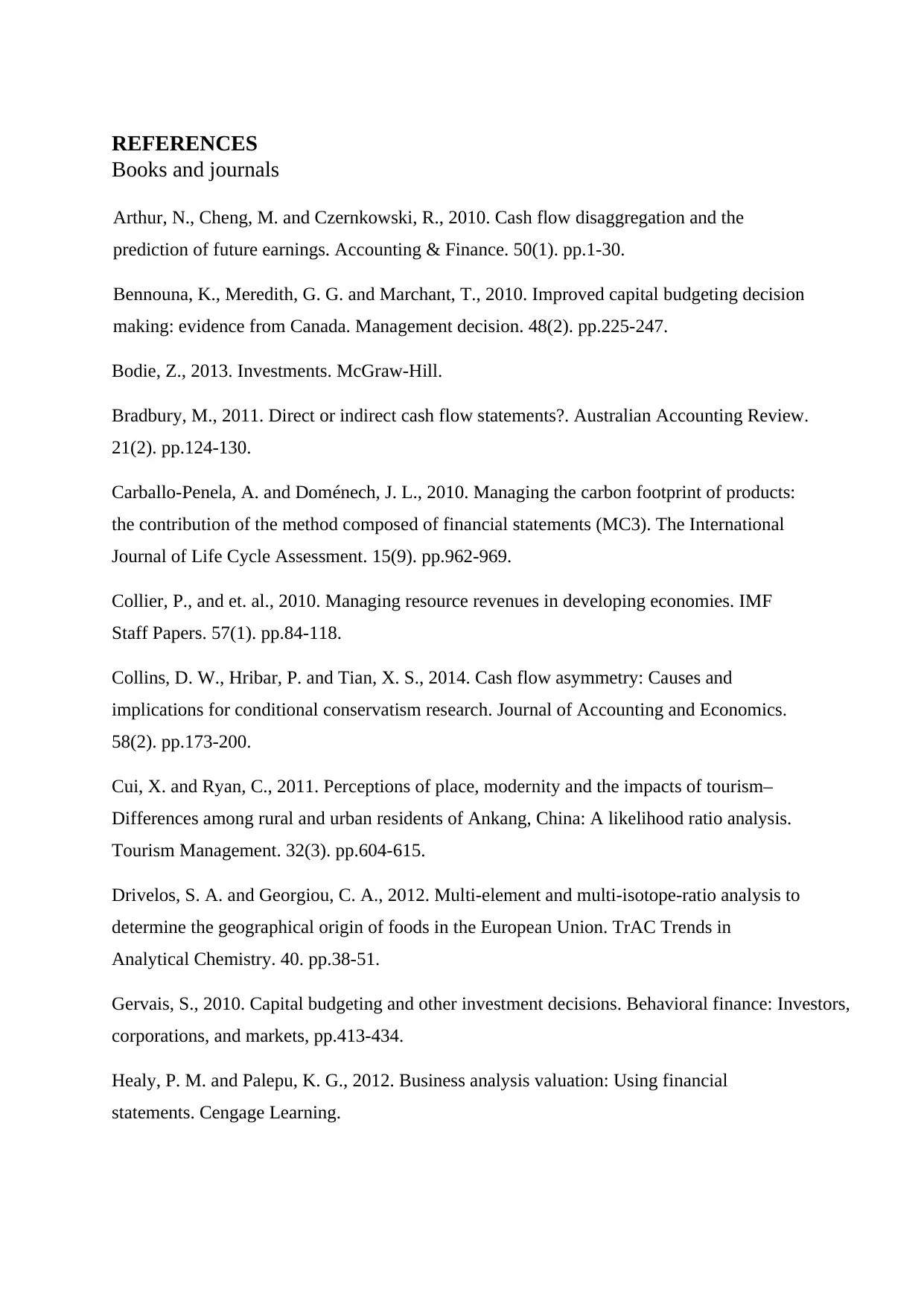
REFERENCES
Books and journals
Arthur, N., Cheng, M. and Czernkowski, R., 2010. Cash flow disaggregation and the
prediction of future earnings. Accounting & Finance. 50(1). pp.1-30.
Bennouna, K., Meredith, G. G. and Marchant, T., 2010. Improved capital budgeting decision
making: evidence from Canada. Management decision. 48(2). pp.225-247.
Bodie, Z., 2013. Investments. McGraw-Hill.
Bradbury, M., 2011. Direct or indirect cash flow statements?. Australian Accounting Review.
21(2). pp.124-130.
Carballo-Penela, A. and Doménech, J. L., 2010. Managing the carbon footprint of products:
the contribution of the method composed of financial statements (MC3). The International
Journal of Life Cycle Assessment. 15(9). pp.962-969.
Collier, P., and et. al., 2010. Managing resource revenues in developing economies. IMF
Staff Papers. 57(1). pp.84-118.
Collins, D. W., Hribar, P. and Tian, X. S., 2014. Cash flow asymmetry: Causes and
implications for conditional conservatism research. Journal of Accounting and Economics.
58(2). pp.173-200.
Cui, X. and Ryan, C., 2011. Perceptions of place, modernity and the impacts of tourism–
Differences among rural and urban residents of Ankang, China: A likelihood ratio analysis.
Tourism Management. 32(3). pp.604-615.
Drivelos, S. A. and Georgiou, C. A., 2012. Multi-element and multi-isotope-ratio analysis to
determine the geographical origin of foods in the European Union. TrAC Trends in
Analytical Chemistry. 40. pp.38-51.
Gervais, S., 2010. Capital budgeting and other investment decisions. Behavioral finance: Investors,
corporations, and markets, pp.413-434.
Healy, P. M. and Palepu, K. G., 2012. Business analysis valuation: Using financial
statements. Cengage Learning.
Books and journals
Arthur, N., Cheng, M. and Czernkowski, R., 2010. Cash flow disaggregation and the
prediction of future earnings. Accounting & Finance. 50(1). pp.1-30.
Bennouna, K., Meredith, G. G. and Marchant, T., 2010. Improved capital budgeting decision
making: evidence from Canada. Management decision. 48(2). pp.225-247.
Bodie, Z., 2013. Investments. McGraw-Hill.
Bradbury, M., 2011. Direct or indirect cash flow statements?. Australian Accounting Review.
21(2). pp.124-130.
Carballo-Penela, A. and Doménech, J. L., 2010. Managing the carbon footprint of products:
the contribution of the method composed of financial statements (MC3). The International
Journal of Life Cycle Assessment. 15(9). pp.962-969.
Collier, P., and et. al., 2010. Managing resource revenues in developing economies. IMF
Staff Papers. 57(1). pp.84-118.
Collins, D. W., Hribar, P. and Tian, X. S., 2014. Cash flow asymmetry: Causes and
implications for conditional conservatism research. Journal of Accounting and Economics.
58(2). pp.173-200.
Cui, X. and Ryan, C., 2011. Perceptions of place, modernity and the impacts of tourism–
Differences among rural and urban residents of Ankang, China: A likelihood ratio analysis.
Tourism Management. 32(3). pp.604-615.
Drivelos, S. A. and Georgiou, C. A., 2012. Multi-element and multi-isotope-ratio analysis to
determine the geographical origin of foods in the European Union. TrAC Trends in
Analytical Chemistry. 40. pp.38-51.
Gervais, S., 2010. Capital budgeting and other investment decisions. Behavioral finance: Investors,
corporations, and markets, pp.413-434.
Healy, P. M. and Palepu, K. G., 2012. Business analysis valuation: Using financial
statements. Cengage Learning.
Paraphrase This Document
Need a fresh take? Get an instant paraphrase of this document with our AI Paraphraser
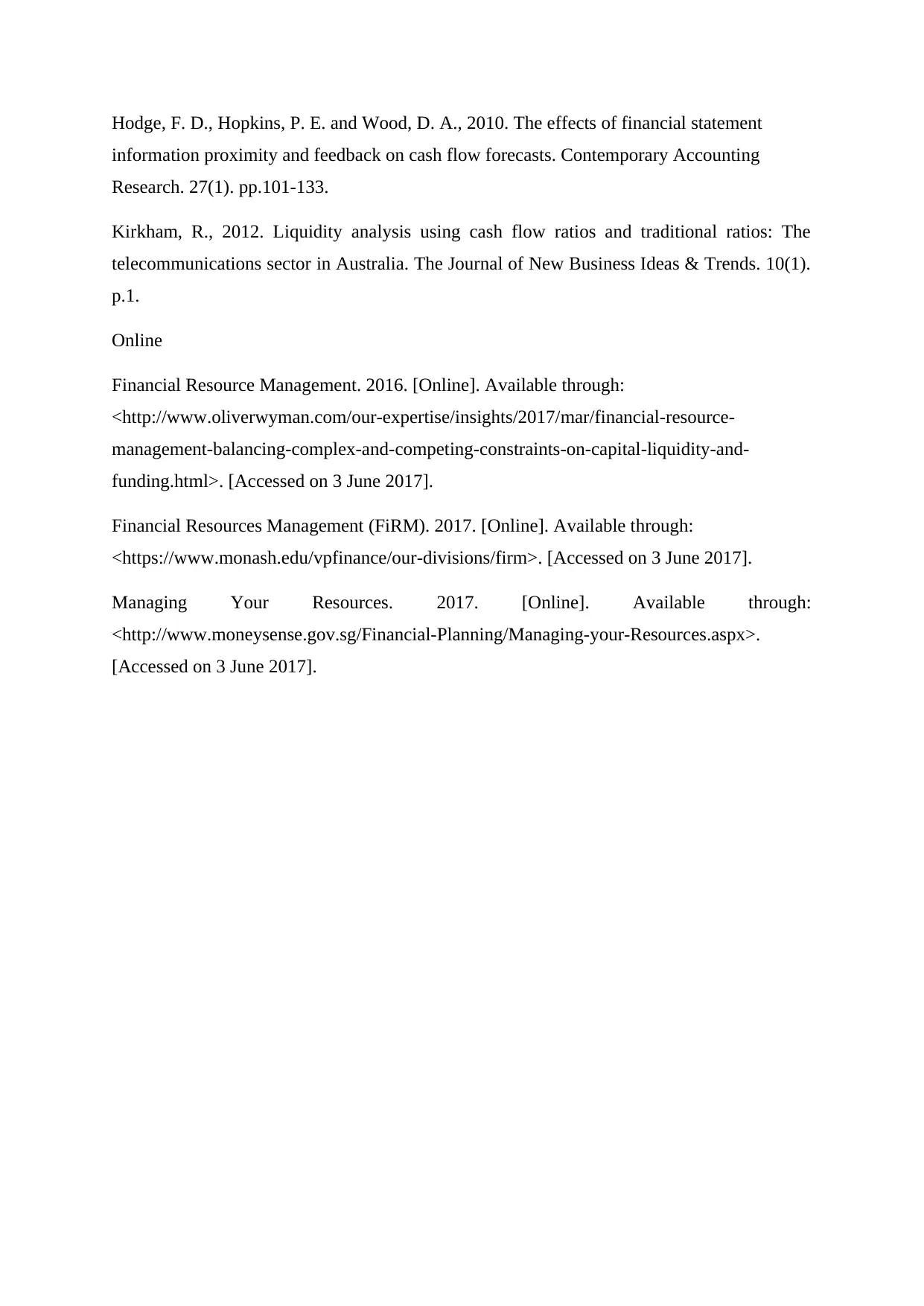
Hodge, F. D., Hopkins, P. E. and Wood, D. A., 2010. The effects of financial statement
information proximity and feedback on cash flow forecasts. Contemporary Accounting
Research. 27(1). pp.101-133.
Kirkham, R., 2012. Liquidity analysis using cash flow ratios and traditional ratios: The
telecommunications sector in Australia. The Journal of New Business Ideas & Trends. 10(1).
p.1.
Online
Financial Resource Management. 2016. [Online]. Available through:
<http://www.oliverwyman.com/our-expertise/insights/2017/mar/financial-resource-
management-balancing-complex-and-competing-constraints-on-capital-liquidity-and-
funding.html>. [Accessed on 3 June 2017].
Financial Resources Management (FiRM). 2017. [Online]. Available through:
<https://www.monash.edu/vpfinance/our-divisions/firm>. [Accessed on 3 June 2017].
Managing Your Resources. 2017. [Online]. Available through:
<http://www.moneysense.gov.sg/Financial-Planning/Managing-your-Resources.aspx>.
[Accessed on 3 June 2017].
information proximity and feedback on cash flow forecasts. Contemporary Accounting
Research. 27(1). pp.101-133.
Kirkham, R., 2012. Liquidity analysis using cash flow ratios and traditional ratios: The
telecommunications sector in Australia. The Journal of New Business Ideas & Trends. 10(1).
p.1.
Online
Financial Resource Management. 2016. [Online]. Available through:
<http://www.oliverwyman.com/our-expertise/insights/2017/mar/financial-resource-
management-balancing-complex-and-competing-constraints-on-capital-liquidity-and-
funding.html>. [Accessed on 3 June 2017].
Financial Resources Management (FiRM). 2017. [Online]. Available through:
<https://www.monash.edu/vpfinance/our-divisions/firm>. [Accessed on 3 June 2017].
Managing Your Resources. 2017. [Online]. Available through:
<http://www.moneysense.gov.sg/Financial-Planning/Managing-your-Resources.aspx>.
[Accessed on 3 June 2017].
1 out of 14
Related Documents
Your All-in-One AI-Powered Toolkit for Academic Success.
+13062052269
info@desklib.com
Available 24*7 on WhatsApp / Email
![[object Object]](/_next/static/media/star-bottom.7253800d.svg)
Unlock your academic potential
© 2024 | Zucol Services PVT LTD | All rights reserved.





